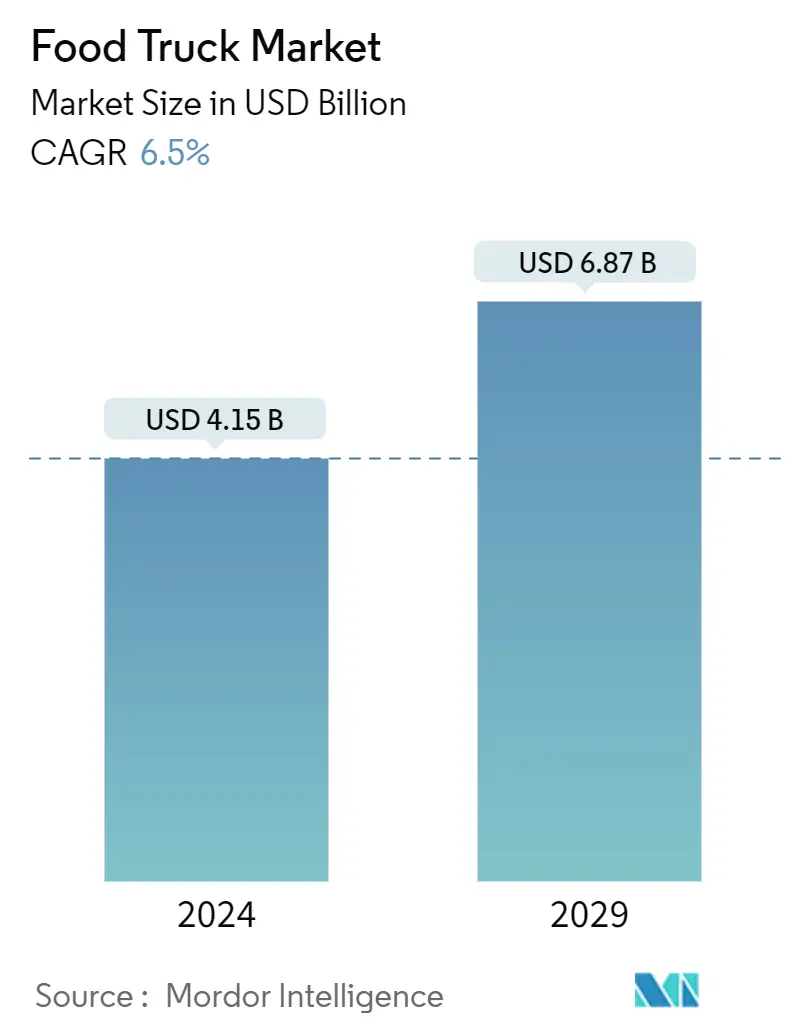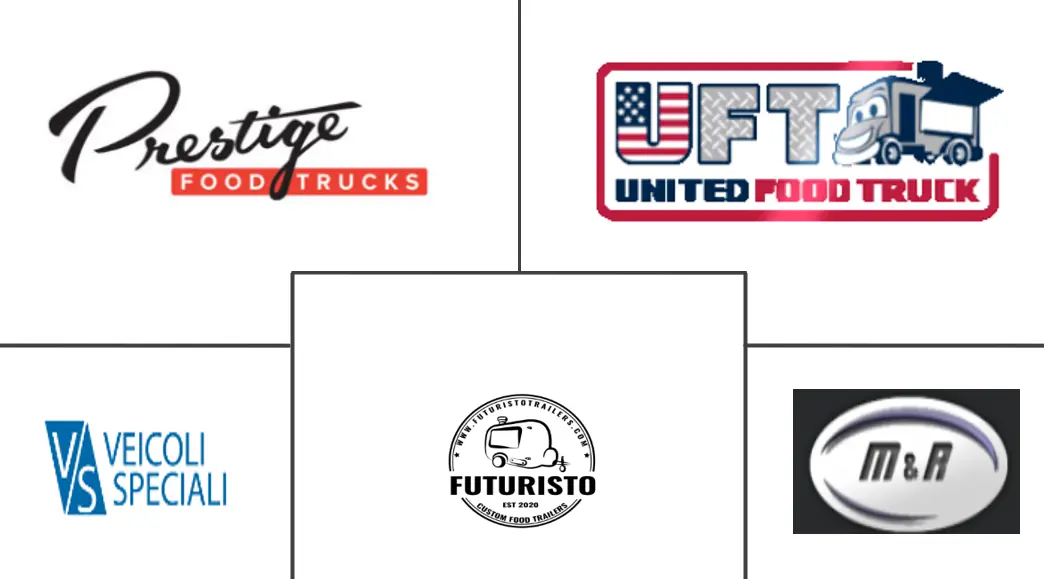Market Size of Food Truck Industry

| Study Period | 2019 - 2029 |
| Market Size (2024) | USD 4.15 Billion |
| Market Size (2029) | USD 6.87 Billion |
| CAGR (2024 - 2029) | 6.50 % |
| Fastest Growing Market | North America |
| Largest Market | North America |
Major Players
*Disclaimer: Major Players sorted in no particular order |
Food Truck Market Analysis
The Food Truck Market size is estimated at USD 4.15 billion in 2024, and is expected to reach USD 6.87 billion by 2029, growing at a CAGR of 6.5% during the forecast period (2024-2029).
The food truck market has experienced substantial growth over the past decade, emerging as a dynamic and integral part of the broader foodservice industry. This industry, characterized by its mobility, flexibility, and unique culinary offerings, has evolved from a fringe novelty into a mainstream foodservice phenomenon. Technology plays a crucial role in the evolution and success of the food truck market. Modern food trucks are equipped with advanced kitchen equipment that enhances their ability to efficiently prepare a wide range of dishes. Moreover, the integration of point-of-sale (POS) systems and mobile payment solutions has streamlined the transaction process, making it easier for customers to order and pay for their meals.
Social media and digital marketing are also pivotal in promoting and growing food trucks. Platforms like Instagram, Facebook, and Twitter are extensively used by food truck operators to engage with customers, announce locations, promote menu items, and build a loyal following. This digital presence increases visibility and fosters a sense of community and direct interaction with customers.
While the food truck market offers numerous opportunities, it also faces regulatory challenges that vary significantly by region. Local governments impose regulations on food safety, health standards, parking permits, operating hours, and zoning laws. Compliance with these regulations is essential for food truck operators, but navigating the complex and often inconsistent regulatory landscape can be challenging.
The food truck market is highly competitive, with numerous operators vying for customer attention. Successful food truck businesses often differentiate themselves through unique branding, high-quality food, exceptional customer service, and strategic location choices. Collaboration with local businesses and participation in food truck festivals and community events can also enhance visibility and customer engagement.
The COVID-19 pandemic had a mixed impact on the food truck market. While some operators faced significant challenges due to lockdowns, reduced foot traffic, and event cancellations, others adapted by leveraging their mobility and outdoor service model to continue operating. The pandemic accelerated the adoption of contactless payment systems and online ordering, which have now become standard practices in the industry.
Food trucks also played a crucial role in supporting communities during the pandemic by providing accessible and convenient dining options when traditional restaurants were closed or limited in capacity. This resilience and adaptability reinforced the food truck market's position as a vital component of the foodservice industry.
The food truck market has evolved into a dynamic and integral segment of the foodservice industry, characterized by its flexibility, innovation, and adaptability. The combination of changing consumer preferences, technological advancements, and economic advantages continues to drive growth and diversification in the market.
Food Truck Industry Segmentation
A food truck is a motorized vehicle, such as a van or trailer, from which food is sold. It typically contains cooking facilities where the food is prepared.
The food truck market is segmented by type, size, application, and geography. On the basis of type, the market is segmented into vans, trailers, trucks, and other types. By size, the market is segmented into up to 14 feet and above 14 feet. By application, the market is segmented into fast food, vegan and meat plant, bakery, and other applications. By geography, the market is segmented into North America, Europe, Asia-Pacific, and the Rest of the World. The report offers the market sizes and forecasts for all the above segments in terms of value (USD).
| Type | |
| Vans | |
| Trailers | |
| Trucks | |
| Other Types |
| Size | |
| Up to 14 Feet | |
| Above 14 Feet |
| By Application Type | |
| Fast Food | |
| Vegan and Meat Plant | |
| Bakery | |
| Other Applications |
| Geography | ||||||||
| ||||||||
| ||||||||
| ||||||||
|
Food Truck Market Size Summary
The food truck market is poised for substantial growth over the forecast period, driven by increasing demand for quick service restaurants and the rising cost of traditional restaurant spaces. This trend is further bolstered by the growing popularity of food trucks among commercial restaurants, which are expanding their reach by launching food trucks in prime locations. The normalization of restrictions globally has also contributed to the market's expansion, with innovations such as driverless food delivery trucks enhancing operational efficiency. The shift in consumer preferences towards fast food and beverages, coupled with rapid urbanization and increased female workforce participation, presents significant opportunities for the food truck industry.
Regionally, Europe leads the food truck market in terms of revenue, with events like the Europe Street Food Festival boosting demand. The popularity of electric and hybrid vans in Europe is also contributing to market growth. In North America, the low capital cost and availability of prime locations make food trucks an attractive business venture, with states like California, Texas, and Florida witnessing significant activity. The market is supported by key players such as Prestige Food Trucks and United Food Trucks United LLC, and is further encouraged by supportive government policies in various countries. Innovations in vehicle technology, such as hydrogen fuel cell food trucks, are also expected to drive market growth during the forecast period.
Food Truck Market Size - Table of Contents
-
1. MARKET DYNAMICS
-
1.1 Market Drivers
-
1.1.1 Increasing Consumption of Fast Food Expected to Drive the Market
-
-
1.2 Market Restraints
-
1.2.1 Increase in Online Food Deliveries May Hamper Market Growth
-
-
1.3 Porter's Five Forces Analysis
-
1.3.1 Bargaining Power of Suppliers
-
1.3.2 Bargaining Power of Buyers/Consumers
-
1.3.3 Threat of New Entrants
-
1.3.4 Threat of Substitute Products
-
1.3.5 Intensity of Competitive Rivalry
-
-
-
2. MARKET SEGMENTATION (Market Size by Value - USD)
-
2.1 Type
-
2.1.1 Vans
-
2.1.2 Trailers
-
2.1.3 Trucks
-
2.1.4 Other Types
-
-
2.2 Size
-
2.2.1 Up to 14 Feet
-
2.2.2 Above 14 Feet
-
-
2.3 By Application Type
-
2.3.1 Fast Food
-
2.3.2 Vegan and Meat Plant
-
2.3.3 Bakery
-
2.3.4 Other Applications
-
-
2.4 Geography
-
2.4.1 North America
-
2.4.1.1 United States Of America
-
2.4.1.2 Canada
-
2.4.1.3 Mexico
-
2.4.1.4 Rest of North America
-
-
2.4.2 Europe
-
2.4.2.1 Germany
-
2.4.2.2 United Kingdom
-
2.4.2.3 France
-
2.4.2.4 Italy
-
2.4.2.5 Spain
-
2.4.2.6 Rest of Europe
-
-
2.4.3 Asia-Pacific
-
2.4.3.1 India
-
2.4.3.2 China
-
2.4.3.3 Japan
-
2.4.3.4 South Korea
-
2.4.3.5 Rest of Asia-Pacific
-
-
2.4.4 Rest of the World
-
2.4.4.1 Brazil
-
2.4.4.2 Saudi Arabia
-
2.4.4.3 United Arab Emirates
-
2.4.4.4 South Africa
-
-
-
Food Truck Market Size FAQs
How big is the Food Truck Market?
The Food Truck Market size is expected to reach USD 4.15 billion in 2024 and grow at a CAGR of 6.5% to reach USD 6.87 billion by 2029.
What is the current Food Truck Market size?
In 2024, the Food Truck Market size is expected to reach USD 4.15 billion.

